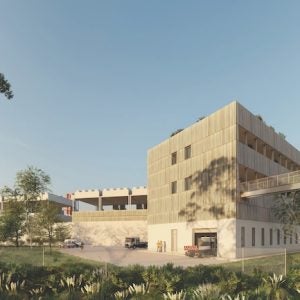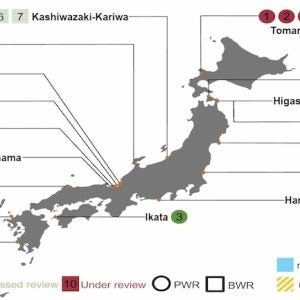
There are records of vertical axis wind turbines as far back as 9th century Persia or even the 7th century BC Afghan highlands. These early VAWTs were simple devices based on aerodynamic drag; one side of the turbine was covered and the wind simply pushed the blades on the other side. The far more efficient aerodynamic-lift-based VAWT was invented
by Georges Darrieus in France as late as the 1920s, patenting both the curved bladed “egg beater” VAWT (here simply called Darrieus- turbine) and the straight-bladed VAWT (here called H-rotor). Although Darrieus himself built a number of both curved- and straight bladed small-scale models, the first power-producing, aerodynamic-lift-based VAWTs where constructed by fellow Frenchman Jean-Baptiste Morel who in the 1950s built a number of straight-bladed Darrieus turbines, ranging up to 7 kW, in southern France.
Researchers at the National Research Council of Canada (CNCR) re-invented the VAWT in the mid-1960s, apparently unaware of the long-forgotten earlier French endeavours.
The Canadian research was rediscovered in the 1970s by Sandia National Laboratories, which besides their main mission to develop nuclear weapons, had been assigned by the US Department of Energy to the investigation of alternative energy resources.
Sandia built a 60 kW Darrieus turbine near Albuquerque, NM, in 1976, which at the time became the largest VAWT ever built. Although Sandia was at the centre of the North American VAWT development effort during the 1970s and 1980s they only built one utility-scale (by which we here mean ≥100 kW) VAWT, a 500 kW Darrieus turbine erected in 1988 in Bushland, TX. This experimental turbine featured variable speed, a strut-free design and it was designed so that most parts could be altered for research purposes. The lack of struts was probably the main factor in reaching a power coefficient (ratio of electric power output to wind energy input) of 0.43, which most likely still stands as a record for utility sized VAWTs.
North American Darrieus efforts
Collaborating with, or using technology from CNRC or Sandia, several corporations started trying to commercialise Darrieus type VAWTs during the 1970s/80s.
In Canada, the aluminum manufacturer DAF Indal had become the main VAWT collaborator with CNRC and in 1977 they broke the size record set by Sandia the year before with their 230 kW Darrieus turbine, which was installed on Magdalen Island in the Gulf of Saint Lawrence in Quebec, Canada. This turbine is also famous for proving that VAWTs indeed can be self-starting. In 1978, technicians left the rotor de-coupled from the drivetrain overnight but high winds during the night made the rotor go into overspeed, which resulted in a guy-wire failure and the rotor ultimately corkscrewing itself to the ground.
In 1983-84, DAF-Indal built three 500 kW turbines, which basically were higher rated versions of the 230 kW turbine. One of the turbines, which was placed in the San Gorgonio Pass near Palm Springs, CA, collapsed during a pre-commissioning guy-tension test, sadly taking the life of an engineer standing on top of it when it fell. Another of the turbines, which was situated at Prince Edward Island, also fell to the ground, after a blade-failure in 1985. DAF- Indal ultimately halted their VAWT programme, in 1991.
In the late 1970s the Pittsburgh, PA, based aluminium company ALCOA started developing VAWTs under a technology transfer agreement with Sandia. ALCOA built a number of large Darrieus turbines, including three 500 kW machines, which by 1980 became the largest VAWT built so far. One of the 500 kW turbines, located in the San Gorgonio Pass,
CA, collapsed just before the 1981 California Energy Commission Conference in adjacent Palm Springs. A power outage resulted in the rotor over-speeding, and the blades breaking loose from their lower attachment and slicing off the guy cables before flying off to a distance of about 300 m, and the turbine falling to the ground. Naturally, the planned demonstration had to be cancelled but, boldly, a video of the incident was instead shown during the conference, receiving a standing ovation from the audience. Ultimately, ALCOA cancelled its VAWT programme, although parts of it were sold to newly established VAWTPOWER Inc, which installed 40 turbines in the San Gorgonio Pass between 1983 and 1984. This facility, the first real VAWT farm, was operational as of 1988.
When it comes to VAWT farms, FloWind spings to mind. FloWind installed more than 500 turbines in the Tehachapi Pass near Los Angeles and the Altamont Pass in the San Francisco Bay area. Their 170 kW and 200 kW models were installed between 1983 and 1986 and the total installed capacity amounted to about 95 MW. By the time the last FloWind turbines entered operation, in 2004, they had generated close to a total of 1 TWh of electricity over their lifetimes. By 2010 all the FloWind turbines had been removed, although remains can be found in the form of a road barrier at a hill crest passage in the Tehachapi Pass.
In 1986, a FloWind-19 had a catastrophic failure that threw a blade into an adjacent measurement trailer, destroying the DOE/ Sandia computer inside. This was the beginning of the end as this scared off investors and FloWind went bankrupt.
In common with the other above mentioned Darrieus turbine developers, FloWind used aluminium blades, which were designed to flex. Due to aluminium’s poor ability to withstand cyclic stress this led to fatigue induced failures. These problems caused FloWind turbines to experience more down time than the horizontal axis wind turbines being installed in California at the same time. After a reorganisation in the early 1990s, two glass-fibre bladed prototypes were built, but this proved to be too little too late, and one of the glass-fibre bladed turbines collapsed during high winds.
A somewhat unusual Darrieus turbine design was used by Canadian company Adecon, which employed an external lattice framework to replace the guy cables. In 1984 they built a 17 m, 125 kW turbine on Prince Edward Island. The turbine, which had the rotor placed 17 m above ground, only operated for a few hours before overspeeding and destroying itself.
After a reorganisation, Adecon installed ten 150 kW turbines near Pincher Creek, Alberta. These turbines lacked the rotor support framework but still used lattice masts instead of guy cables. The lattice masts induced resonances, which resulted in component failures. These caused two of the turbines to topple and resulted in most of the others being non-operational most of the time. By 2006 all ten turbines had been removed.
A must-mention is the mighty ÉOLE (French for Aeolus, the ruler of wind in Greek mythology), which was completed in 1987 and situated in Cap-Chat, on the south shore of the Saint Lawrence river in Quebec. With a total height of 110 m, rotating mass of 880 metric tons and rated power of 3.8 MW, ÉOLE broke all previous records and is still by far the largest VAWT ever constructed.
This steel-bladed, variable-speed monster operated until 1993 when the bottom bearing broke. It is pleasing to report that ÉOLE still stands and hosts guided tours during the summer. A visit is highly recommended: ÉOLE is a legend for wind power enthusiasts and the beautiful Gaspé Peninsula is a great place overall. Conveniently, it is possible to have the guided tour conducted in English and if you pay a few extra dollars, you can be taken to ÈOLE’s top platform from where the view is spectacular.
There have been other utility-scale Darrieus turbines, even some built in Europe during the 1980s. But serious attempts have become increasingly rare. The problems with blade fatigue, the necessity for flat terrain to accommodate guy wire attachment and the drawbacks of having the rotor so close to the ground were all reasons for the Darrieus “egg beater” failing to establish itself as a competitor to HAWTs.
Meanwhile in Europe
Partially overlapping with the North American Darrieus developments, VAWTs were also investigated in Europe, but here most focus was put on the H-rotor concept, which has some advantages compared to the conventional Darrieus turbine. Most important, it is usually placed atop a freestanding tower, which makes the rotor higher and renders guy cables unnecessary.
The most well-known and perhaps most ambitious European VAWT project was the one undertaken by British company VAWT Ltd during the 1980s/90s, which sprang from research led by Peter Musgrove at Reading University in the UK.
At first, the VAWT Ltd concept featured variable geometry, which enabled the blades to be folded to regulate power. But after evaluating a 130 kW, variable-geometry turbine, erected in 1986 at Carmarthen Bay in Wales, it was deemed that the power could just as well be stall controlled with fixed, straight blades. Thus, the subsequent 500 kW prototype, erected in 1990, had straight blades. This turbine experienced several failures linked to the power transmission and ultimately a devastating failure of one of the fibreglass blades. Soon after, government funding was halted and the project eventually ended.
In the 1990s, German inventor and entrepreneur Götz Heidelberg started developing a variable-speed, PM-magnet H-rotor concept at the Munich-based company Heidelberg Motor GmbH. In 1991, their first large-scale (300 kW) prototype was installed at Kaiser-Wilhelm-Koog on the German North Sea coast. It used a ground-mounted generator and was supported by guy wires connected to a top bearing allowing the entire tower to rotate (much like a Darrieus turbine). After abandoning the ground based generator five new 300 kW prototypes were developed that had the large multi-pole ring generator placed on top of a tripod tower. After a welding problem resulted in one turbine destroying itself early in 1995, the other machines were taken out of operation and were finally dismantled, in 1997. This also led to the abandonment of an EU-funded development of a 1.2 MW version of the concept and that was also the end of this VAWT endeavour.
Worth mentioning is that Heidelberg installed its smaller, 20 kW, extreme environment version at a German research facility at Antarctica that reportedly operated for 15 years before being decommissioned in 2008.
Continuous efforts
If not even German engineering could make VAWTs hold together, one may have guessed that the concept surely must have been abandoned after the mid 1990s. Well it was not, although it took until 2010 before the next utility-scale H-rotor prototype was built, this time by Swedish company Vertical Wind AB.
In 2010, they erected a 200 kW, direct-drive, variable speed prototype close to Falkenberg on the Swedish west coast. The turbine, which featured a laminated wood tower and in-house manufactured direct-drive, multi-pole PM generator, has mainly been used for measurements but is still operational, although at limited wind speed. Vertical Wind halted their development after losing a key investor in 2010 but still manufacture generators.
Much like the DAF Indal and ALCOA VAWT programmes of the 1970s/80s being aluminium producer initiatives, the Polish VAWT company Anew Institute, which is active today, is a subsidiary of steel manufacturer Stalprodukt SA. Anew erected a 200 kW prototype in 2015 and most prominently a 1.5 MW prototype in 2017, which is second only to ÉOLE, the largest VAWT ever, in terms of installed capacity. Not surprisingly, as much steel as possible is used in the construction, but thankfully at least the blades are made of fibreglass.
What about floating VAWTs?
Floating wind turbines have (for example by trade association WindEurope) been identified as a key enabling technology for major offshore wind energy expansion. The VAWT’s low centre of mass combines well with a floating platform and this has caused a revival of interest in the concept, with a number of floating VAWT projects being initiated during the 2010s.
MODEC, a Japanese company specialising in floating platforms for the oil and gas industry, for example, developed a floating wind and tidal current hybrid power generation system called skwid (Savonius Keel and Wind Turbine Darrieus). The concept consisted of an H-rotor above surface and a Savonius turbine harvesting currents beneath. However, their 500 kW prototype sank twice while being commissioned in 2013/14 and MODEC abandoned its VAWT ambitions.
Another attempt to commercialise floating VAWTs was made by the French company NENUPHAR, which aimed at developing a multi- MW, twin-turbine floating offshore platform.
No large, floating VAWT was ever deployed, but NENUPHAR installed a 600 kW onshore prototype in Fos-sur-Mer on the French Mediterranean coast in 2014 for which different blade configurations were tested. However, in 2018, NENUPHAR entered liquidation after being abandoned by an industrial partner.
Several other floating VAWT development efforts that aspire to be soon deploying large prototypes could be mentioned. But this brief retrospective is restricted to projects that, regardless of final outcome, included actual construction of utility-scale vertical axis turbines. So these ‘paper’ projects are omitted here, but could be the subject of a future report.
Floating niche revives interest
In summary, from being almost extinct, the vertical axis wind turbine concept has enjoyed renewed interest in the last few years, especially for floating offshore platforms. Competing with the horizontal axis concept, which has become more and more technologically developed since beating VAWTs as the wind turbine standard in the 1980s, has become increasingly difficult, but the floating niche market might be the opportunity vertical axis wind turbines have been waiting for.
Author information: Erik Möllerström The Rydberg Laboratory for Applied Sciences, Halmstad University, PO Box 823, SE-301 18 Halmstad, Sweden (erik.mollerstrom@hh.se)
For more details of the VAWTs mentioned as well as other smaller VAWT projects not covered here, the following paper is available open-access: Möllerström E, Gipe P, Beurskens J, Ottermo F, ‘A historical review of installed vertical axis wind turbines rated 100 kW and above’, Renewable & Sustainable Energy Reviews, Vol 105 (2019).






